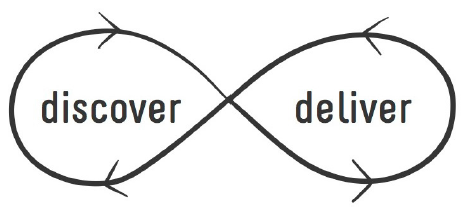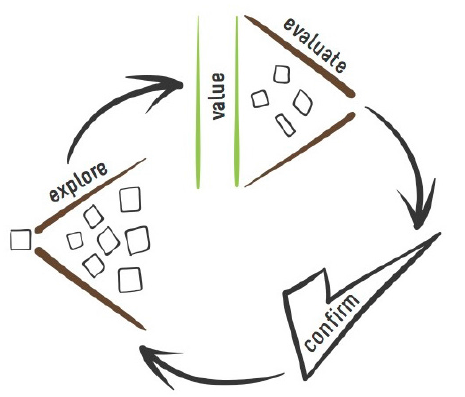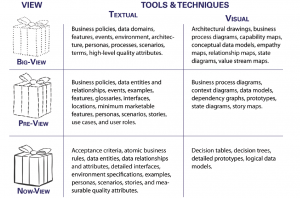Here comes a new post from Ellen Gottesdiener who comes to Stockholm to hold her highly appreciated course Agile Requirements Analysis and Planning for Product Success.
In a recent interview in the New York Times, Panera Bread co-CEO Ronald M. Shaich talks about the importance of developing an organization’s “discovery muscle” as well as its “delivery muscle.” Most companies have worked hard to perfect delivery—how they get work done—he says, because delivery “feels rational, people feel much safer with it, and you can analyze it.” But discovery—the activities you undertake to define or change your product, service, or market—is about “leaps of faith. It’s about trusting yourself. It’s about innovation.” The key, Shaich says, is for the discovery muscle to be at least as strong as the delivery muscle.
He took the words right out of our mouths. This need for balance between discovery and delivery applies in spades to software development. Our new book, Discover to Deliver: Agile Product Planning and Analysis, explicitly makes the case for equally balancing your commitment to these key activities. We define the relationship between them: In lean/agile software development, discovery and delivery are interwoven, interdependent, continuous activities (see figure 1). Each feeds the other.

Traditionally, software teams have been out of balance—strong on delivery but weak on discovery. As a result, they tend to deliver technically excellent software that, unfortunately, may solve the wrong problem, possibly lags the market, or otherwise falls short of meeting the stakeholders’ real needs.
If your team needs to develop its discovery muscle, it’s not really about making a leap of faith. It’s more about making a leap of learning. Let’s look at why and how.
Context Counts
Many teams set themselves up for failure by not including discovery in their process from the very beginning. Before you begin talking about product options (aka requirements), the stakeholders need to hammer out a product vision and goals.
One of your most useful discovery tools is constructing and asking good questions to set the context and determine your mark. What is your company strategy, and how does your vision for the proposed product align with it? Should the strategy be revised in light of recent developments? What is your problem or opportunity? What is the competition doing or not doing? What is your competitive advantage? Are you being too safe? Might there be customers beyond your current market? Who cares?

The vision activity should include people who represent three realms: the business, the customer, and the technology group—all of whom we call the product partners (see figure 2). They need to collaboratively contribute to the vision.
The lean/agile practices we use position value as the chief criterion for planning which product options to develop next. Of course, you’re not working at the level of product options yet, but now—while you’re developing the product vision—is the time for the partners to define their value considerations. A few examples:
- Customer Value Consideration: Save time, money, and frustration.
- Business Value Consideration: Support our growth strategy.
- Technology Value Consideration: Ensure a scalable technology platform.
Working Together
Discovery is a team sport, not a spectator sport. Your discovery team must include diverse voices and perspectives. The partners collaboratively expand their thinking, look at the problem with fresh eyes, and consider new or unique possibilities. They reach far and wide. They listen to differing perspectives and reach agreement. You gain two benefits: you exploit the wisdom (attributed to Aristotle) that the whole is greater than the sum of its parts, and the product partners collectively own the discoveries.
As you collaborate in discovery, it’s important not to bow to conventional wisdom. It’s easy for your discovery muscle to shorten and tighten if you don’t stretch it. Instead, critique the way you’ve always done things. Be courageous, creative, and curious. Find out why. Moreover, as Shaich notes, defying conventional wisdom may help you discover something that gives you a competitive advantage.
Holistic Discovery Practices
Discovery engages the partners in learning and possibilities—it demands problem-seeking and solution-finding. To that end, your discovery process should address the product needs for each of what we call the “7 Product Dimensions” (see figure 3).

Discovering all 7 Product Dimensions gives you a holistic understanding of the product’s functional and nonfunctional needs. You explore options within and across each dimension. This cross-dimension perspective helps inform and balance your discovery.
During a recent discovery workshop at a health care provider, the partners quickly identified “obvious” users such as health care members and health care providers (e.g., physicians). Digging deeper, they discovered the health care medical director, who has unique product needs. Then they considered the users in light of the other dimensions and discovered new interfaces and environments, along with related actions, data, control (business rules), and quality attribute options. This discovery work provided a number of benefits. The partners’ shared understanding of the broad range of product possibilities helped shape the overall architecture, saving future rework. It guided their research on usability needs for complex data-visualization interfaces. And they reduced risk by collectively selecting the high-value options for their first release.
In conjunction with the 7 Product Dimensions, you use the “structured conversation” to frame your discovery sessions into three activities: explore, evaluate, and confirm (see figure 4).

The structured conversation is a lightweight framework that guides the product partners as they learn about the product’s possibilities and decide what to deliver. You explore options for all 7 Product Dimensions. As you evaluate the benefits and risks of each product option, you use the partners’ value considerations to identify high-value options. You also confirm the partners’ understanding of the options.
And importantly, at each new planning session you’re open to exploring, evaluating, and confirming new product options, using your learning from prior deliveries. Thus, the structured conversation helps you balance your discovery and delivery muscles by moderating between the expansive thinking of discovery and the more focused thinking of confirmation and delivery.
Engage Creatively
Discovery is the rich interplay of creativity, new or expansive thinking, and human-centered design. You stretch your discovery muscle, making way for purposeful serendipity.
This aspect of discovery is often referred to as “design thinking,” a newer term for diverge-then-converge practices that inspire, boost, and challenge the partners. Design thinking draws from an amalgamation of disciplines such as visual design, professional facilitation, architecture, industrial engineering, contextual inquiry, participatory design, improvisation, learning games and simulations, and the burgeoning innovation and creativity movement.
Discovery goes beyond writing stories. Design matters. A lot. Your product’s look, feel, color, and aesthetic appeal—its visceral likeability—matter. Space and tools matter, as well. You “uncube” physical space so that people can conveniently and extemporaneously interact as they converse, sketch on posters, walls, or whiteboards, and select from and play with colored posts, markers, and glue to find possibilities and explode problems.
To get there, you can draw from the family of facilitated workshop activities—variously called collaboration activities, serious games, Innovation Games, and more—to spark possibilities and yield serious outcomes. You can also use sketching, brain writing, affinity mapping, or card sorting activities. Techniques such as personas, role play, contextual inquiry, empathy maps, and journey maps help you gain affinity with your users, and you can employ analysis models such as prototypes, state diagrams, data models, and dependency graphs to tap into visual thinking.

Calibrate Your Discovery
You need to adjust your discovery scope depending on your planning horizon—what we’ve termed the Big-View, Pre-View, and Now-View (see figure 5). You might not necessarily start from the top and work down, as long as you have a clear definition of your discovery scope.
In the Big-View (the longest planning horizon, up to two years), your discovery muscle needs to be loose, flexible, and far reaching. At this planning horizon, you discover high-level, generalized possibilities for the product, across all 7 Product Dimensions. You might want to start discovery with a vision statement for the product, or your discovery might lead you to craft the vision.
In the Pre-View (the middle distance, or release view, possibly a few weeks to a month), your discovery muscle is toned and controlled. Your discovery is framed within a clearly defined space to explore, evaluate, and select high-value product needs to enable planning for the next release.
In the Now-View (the shortest view, typically the next iteration: days or weeks), your discovery muscle is taut, ready to spring or sprint. You are focused on a narrowly defined space. You need to discover and define high-value product requirements in sufficient detail to enable immediate development and potential delivery.
Training Your Discovery Muscle
To get the most from discovery, be prepared to stretch, reach, bend, and twist the way you think about your product. At first, you may find training your discovery muscle uncomfortable, even unpleasant. Or the partners may not be willing to discover together. Yet, regularly exercising your discovery muscle improves flexibility and range—you will see your business through different eyes. You will develop skills in discovery and innovation, building muscle memory so that discovery becomes natural, seeming to progress without conscious effort.
Warning: As with any routine, your initial enthusiasm for discovery may dim with time and repetition, and your discoveries may be less powerful. If that happens, look for new ways to spark creativity. Vary your techniques, inject new ones, and play innovation games. Switch roles, and take on a different perspective. Get out of your comfort zone.
Reaching a Shared Understanding
The 7 Product Dimensions and the structured conversation are essential tools that enable the people in the three partner realms to agree on which discovered product needs are high value. The 7 Product Dimensions construct, for example, employs a visual language that all the stakeholders can use in talking about the product. And because of the structure in the structured conversation, the partners become intimately acquainted with the incremental nature of the lean/agile process.
So, what’s the biggest mistake we’ve seen that obliterates the benefits of these powerful tools? Failing to include the right people from beginning to end. The resulting siloed conversations cause people to develop different—often conflicting— definitions of the product to be. Discovery becomes haphazard and undisciplined, scope changes often, and people retreat into the apparently safer, saner world of delivery. As a result, opportunities to make a great product fizzle out.
It’s a Process, Not an Event
At any given time—this year, this release, this iteration— you may discover new product possibilities. That’s the nature of discovery. This means that your discovery muscle needs to be fit and ready to move, explore, and innovate to exploit opportunities.
In the process we advocate, you move your discoveries into delivery so you can validate the value of the product options you chose. You assess what you deliver, and you validate what you have learned. Did the result deliver the anticipated value? If so, keep doing what you’re doing. If not, then loop back using your validated learning to feed subsequent exploration and experimentation.
Successful software teams deliver great products because they invest in ongoing discovery as well as delivery. With frequent exercise, their discovery muscle becomes stronger and more limber and works smoothly in tandem with their delivery muscle.
(Text by Mary Gorman and Ellen Gottesdiener.)




Hi,
Great Blog!
My name is Isabelle and I am currently working with http://www.accessguru.com.au
I just came across your blog and enjoyed the read.
We were hoping we could publish a similar blog on your site?
I have some ideas that I am currently working on:
– What you should know before hiring professional access developers
– Tips when choosing a software developer
– Or another topic of your own.
Looking forward hearing from you.
Thanks for your time,
Isabelle
In different words, the extra successful you become
then the much less you’ll actually win until ultimately you lose any profit
that you just gained.